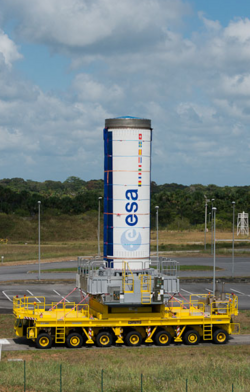 P80 being transferred at Guiana Space Centre P80 being transferred at Guiana Space Centre | |
| Manufacturer | Avio |
|---|---|
| Country of origin | Italy |
| Used on | Vega |
| Associated stages | |
| Derivatives | P120C |
| Launch history | |
| Status | Active |
| Total launches | 21 |
| Successes (stage only) | 21 |
| First flight | 13 February 2012 |
| Last flight | 9 October 2023 |
| Technical details | |
| Height | 10.6 m (34 ft 9 in) |
| Diameter | 3 m (9 ft 10 in) |
| Empty mass | 7,330 kg (16,160 lb) |
| Gross mass | 95,000 kg (209,000 lb) |
| Propellant mass | 88,000 kg (194,000 lb) |
| Maximum thrust | 3,037 kN (683,000 lbf) |
| Specific impulse | 280 s (2.7 km/s) |
| Burn time | 114 seconds |
| Propellant | Aluminium-HTPB 1912 |
P80 is a solid-fuel first-stage rocket motor used on the European Space Agency Vega rocket (in the P80FW version). It was the world's largest and most powerful one-piece solid-fuel rocket engine, being replaced by the larger P120C on 13 July 2022.
History
The P80's development was led by a joint team of ESA, CNES and ASI since 2005, with Avio selected as the prime contractor. The first test of the P80 engine was completed at Centre Spatial Guyanais in November 2006 followed by qualification tests in December 2007. The first launch was completed on 13 February 2012, with the first commercial launch following on 7 May 2012. Total development cost of the engine reached €76 million.
Overview
P80FW is a single monolithic solid rocket motor propelled by hydroxyl-terminated polybutadiene which burns for 114 seconds and is jettisoned at an altitude of 53 km after achieving a relative speed of 1.7 km/s.
The engine shares specifications with Ariane 5 solid rocket boosters - it has the same 3 meter diameter and similar height to the largest segments of the booster. This allows using the same facilities and equipment at the Guiana Propellant Plant for loading the propellant and transporting the engine to the launch site. The nozzle of the P80 is also a direct evolution of the one used in Ariane 5 boosters.
The manufacture process is divided among several European companies. Italian Avio manufactures the main motor case loaded with fuel, performs integration of the components, and final testing. French-Italian Europropulsion manufactures the P80 motor while Regulus performs propellant loading. Aerospace Propulsion Products B.V. from Netherlands builds the igniter. Belgian SABCA produces components for thrust vectoring and the staging skirt. French Herakles manufactures the engine nozzle.
Related development
P120C
The P120C is a wider version of the engine with increased propellant mass to 141,634 kg (312,250 lb), for use in Ariane 6 boosters and Vega C first stage.
As of 2024, an extended version of the P120C, called the P160C, was under development. This booster is 1 metre (3 ft 3 in) longer and has a propellant mass of 155,634 kg (343,114 lb). It will be used in Ariane 6 Block 2 boosters and the Vega E first stage.
See also
References
- "VEGA: 1° Stage - P80 Motor". Avio. Retrieved 14 April 2019.
- ^ "Vega Launcher - Launcher Composition". European Launch Vehicle S.p.A. P.IVA. Archived from the original on 4 March 2016. Retrieved 22 July 2014.
- ^ "Press Kit - Vega qualification flight VV01" (PDF). ESA. Retrieved 22 July 2014.
- "Vega Satellite Launcher" (PDF). Avio. Archived from the original (PDF) on 23 September 2015. Retrieved 22 July 2014.
- "ESA's new Vega launcher scores success on maiden flight". ESA. 13 February 2012. Retrieved 16 December 2015.
- "Vega maiden launch goes to plan". Flightglobal. 13 February 2012. Retrieved 16 December 2015.
- "Vega's second success 'confirms functionality'". Flightglobal. 9 May 2013. Retrieved 16 December 2015.
- APP Aerospace Propulsion Products B.V. (7 May 2013). "APP: Space - Specialist in the development and production of igniters for rocket engines". Archived from the original on 4 September 2013. Retrieved 14 January 2014.
- "P120 C solid propellant motor". www.avio.com. Archived from the original on 4 June 2019.
- ESA-developed P120C solid rocket motor enters production April 2022
| Rocket engines and solid motors for orbital launch vehicles | ||||||||||||||||||
|---|---|---|---|---|---|---|---|---|---|---|---|---|---|---|---|---|---|---|
| Liquid fuel |
|  | ||||||||||||||||
| Solid fuel |
| |||||||||||||||||
| ||||||||||||||||||